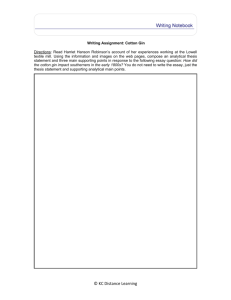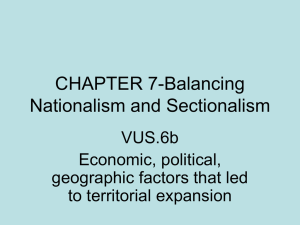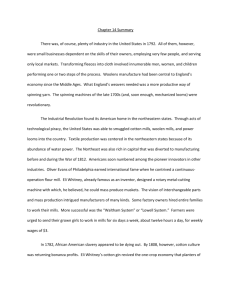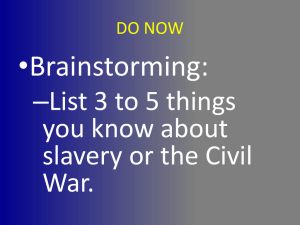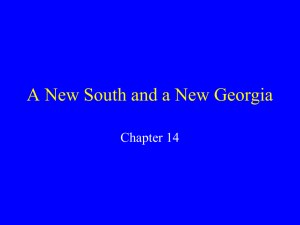Chapter 11 Test Review
advertisement
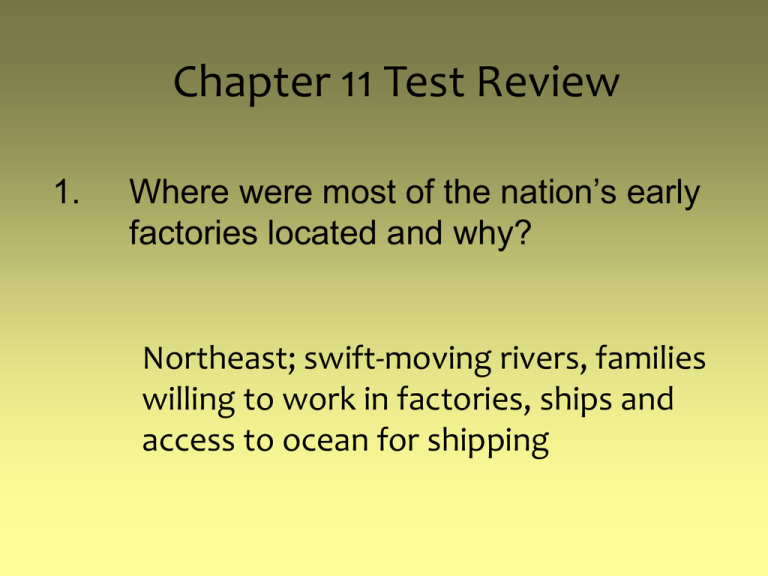
Chapter 11 Test Review 1. Where were most of the nation’s early factories located and why? Northeast; swift-moving rivers, families willing to work in factories, ships and access to ocean for shipping Chapter 11 Test Review 2. Why did the “Lowell girls” keep working in the early years at the Lowell mills despite the deafening noise and long hours? High paying job, and most married after only a few years Chapter 11 Test Review 3. How did Eli Whitney’s invention of the interchangeable part transform manufacturing? allowed the mass production of parts that were exactly alike Chapter 11 Test Review 4. What did Samuel F.B. Morse invent and what did it do? Telegraph; allowed people to communicate quickly over long distances Chapter 11 Test Review 5. How did the telegraph, the steampowered locomotive, and the steamboat unite the different regions of the country? faster communication and transportation created a stronger bond between the regions as trade and interdependence increased Chapter 11 Test Review 6. What body of water connected the Hudson River and Lake Erie? Erie Canal Chapter 11 Test Review 7. By 1841, what two cities did the National (Cumberland) Road connect? Cumberland, Maryland and Vandalia, Illinois Chapter 11 Test Review 8. What did Eli Whitney invent in 1793 and how did it change the south? Cotton Gin; expanded slavery, southerners grew more cotton, triggered westward expansion Chapter 11 Test Review 9. In what ways did the cotton gin affect Native Americans? Native Americans lost more land as cotton plantations expanded Chapter 11 Test Review 10. In 1840, what percentage of African Americans in the south were free 8% Chapter 11 Test Review 11. What percentage of white families in the south owned slaves in 1840? Approximately 30% Chapter 11 Test Review 12. In what ways did slaves depend on spirituals? Expression of religious beliefs, communicate in coded messages Chapter 11 Test Review 13. Who was Nat Turner and for what is he best known? Slave and preacher who, along with 70 other slaves, was responsible for leading a bloody slave revolt known as “Turner’s Rebellion” Chapter 11 Test Review 14. What was the name of the plan to make the United States economically self-sufficient? “American System” Chapter 11 Test Review 15. What was the reason for the close bond that developed between the Midwest and Northeast Trade in agricultural and manufactured products Chapter 11 Test Review 16. How did the growth of the textile mills in the Northeast affect the demand for crops in the South? Demand for cotton increased as textile mills production capacities increased Chapter 11 Test Review 17. How did the Supreme Court’s rulings in McCulloch v. Maryland and Gibbons v. Ogden affect the national government? Strength of the Federal Government increased Chapter 11 Test Review 18. What was the court’s decision in McCulloch v. Maryland? States were prohibited from taxing a national bank Chapter 11 Test Review 19. What was the court’s decision in Gibbons v. Ogden? Only the Federal Government could regulate interstate commerce Chapter 11 Test Review 20. What did Southern slaveholders do to try and control free African Americans? They passed laws severely limiting the rights of free African Americans Chapter 11 Test Review 21. What two foreign nations did the United States have border disputes with in 1818 and 1819? Spain and Britain Chapter 11 Test Review 22. What treaty with Spain gave the United States control of Florida and the Oregon Country? Adams-Onis Treaty of 1819 Chapter 11 Test Review 23. What were the sectional interests of each of the following?: South – cotton and slavery Northeast – manufacturing and trade West – cheap land and good transportation Chapter 11 Test Review 24. Which plan allowed slavery to spread to some areas but not to others in order to maintain a balance of power between slave and free states? Missouri Compromise of 1820 Chapter 11 Test Review 25. What is sectionalism? Placing the interests of one’s state or region above the interests of the nation Chapter 11 Test Review 26. What is nationalism? A feeling of pride, loyalty, and protectiveness toward one’s country Chapter 11 Test Review 27. What effectively closed the Americas to further European colonization in exchange for America’s promise to stay out of European affairs? The Monroe Doctrine Chapter 11 Test Review 28. What agreement limited the naval forces of both the United States and Britain in the Great Lakes Rush-Bagot Agreement of 1817 Chapter 11 Test Review 29. Who did President Monroe send to put a stop to the Seminole raids that plagued Georgia in the early 1800s General Andrew Jackson Chapter 11 Test Review 30. What was Robert Fulton’s contribution to the Industrial Revolution? The Steamboat, “Clermont”, which could move against the current or strong winds Chapter 11 Essays 1. The Cotton Gin o o o o Discuss its Impact on slavery Discuss its Impact on cotton production Discuss its impact on Native Americans Discuss its impact on Westward expansion Chapter 11 Essays 1. Missouri Compromise o o o o o What was the issue? What was at stake? Who suggested the plan? Who were the players? How did it resolve the issue Chapter 11 Essays 1. Lowell Mills o o o How did it benefit women? What was unique about the mill? How did it impact the South? Chapter 11 Essays 1. Samuel F.B. Morse o o o What did he invent? How did it work? What was its impact on the United States? How was it an improvement? o
